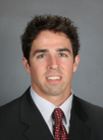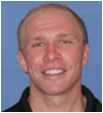
Craig Liebenson
How and why did you get into the field of Sports Medicine / chiropractic studies?
Mainly because I felt strongly an allopathic orientation to health & disease was too focused on the disease end of the spectrum and not enough on health & wellness.
Who in the field has influenced or helped you the most? Influenced your philosophy? What have you learned from them that you can you share?
Karel Lewit & Vladimiir Janda the great Czech neurologists have had by far the greatest influence on me. They have taught me that functional pathology of the motor system holds the key to reducing pain, preventing injury & enhancing performance. Their approach focuses in the broadest sense on all structures of the locomotor system (skin, fascia, muscle, tendon, ligament, and joint). What is most important are the faulty movement patterns that are "memorized" in the CNS and lead to tissue strain.
Name 3-5 books everyone helping basketball athletes should have in their library and why?
- Stuart McGill - because it gives a ‘no-nonsene' approach to spinal biomechanics 101. Sadly a horribly misunderstood subject
- Karel Lewit - Musculoskeletal Medicine - it gives the foundation for an integrated approach to manipulation & rehabilitation
- Joanne Elphinston - Stability, Sport and Performance Movement - great illustrations of stable & unstable movements
- Vern Gambetta - Any of his books - because he know how to coach better than anyone else
What is the last book you read and why?
The Talent Code - Speaks about "how" one learns. A very rehab oriented book that teaches us that finding "correctable errors" and demonstrating how to re-model movement leads to great prowess in any physical discipline if practiced enough to make it automatic. His ideas regarding myelination of neural pathways through repitition is nothing short of revolutionary.
Generally speaking, what is your philosophy for evaluating/treating a basketball player? How does it differ from other sport athletes?
I always evaluate all athletes & patients for functional deficits. Of course in basketball the feet are very important. I pay a little more attention in them to transverse arch function. Quad dominance is a big problem for basketball players too. Posterior chain facilitation is always a key.
What has been the biggest mistake you made early in your career?
Too much emphasis on manual therapy and other passive modalities. Too much emphasis on floor exercises. Having patients attribute success to my treatment rather than to self-care.
How has your philosophy changed in the last 3-5 years?
Due to Gary Gray's influence I always try to work in functional positions first. It used to be my goal, but now it is my means too!
What advice would you give for young professionals looking to follow in your footsteps?
Study from the masters - Gray, Cook, Butler, McGill, Hewett, Falsone, etc.. Listen to your patients. Their goal is your goal. Assess function, trust it "A Priori". Perform the best functional evaluation your athletes have ever had.
What areas do you address for those players that don't play significant minutes during the in-season?
Since they are not suffering overload - instead of a band-aid approach - their in-season program can be more corrective. Almost more of an off-season mentality.
What is your philosophy on basketball conditioning? Some sport coaches believe in long distance training to improve basketball specific endurance? What is your opinion?
I am a fast-twitch convert. Too much cardiovascular training can deaden the muscles. I prefer to focus on glut activation, balance reaches, & agility/speed work.
Please discuss your philosophy on taping/bracing ankles. Does this cause problems elsewhere? What are the advantages of taping/bracing?
Nearly all players will tell you they need to be taped. If it causes more knee problems only a controlled clinical trial can tell.
How do you address Low Back Pain in your basketball athletes? Can you discuss a specific case study?
I have seen numerous athletes who think they have an SI problem & needed manipulation. Most had gluteus medius insufficiency. I have also seen many players w/ sciatica. McKenzie plus Butler's sliders have been highly effective. Usually, their posterior hip capsules were tight. They needed to learn to hip hinge, maintain lumbar lordosis when in defensive posture. Lots of crab walk training.
What assessments or evaluations do you use with your players during pre-season? Summer months?
Great question. #1 is looking for quad dominance & medial collapse of the knee. Summer is more corrective. Pre-season is already almost too late to fully address muscle imbalances.
How do you address knee pain in the basketball athlete?
Check for asymetric glut medius strength/coordination. Hip rotation deficits, medial collapse of the knee. Ankle mobility issues.
There has been a lot of debate about the squat and single leg training. In your opinion, should basketball players a squat? Year round? Only summer? Never? What would cause you to remove squatting from their program?
Don't squat if there is a serious meniscal problem. Single leg training is essential. But, I see a lot of stupid training w/ labile surfaces before sub-talar neutral can be maintained. It is not about using balance pads or Gray's maximum excursions. Rather, it is about building stable functional capacity. How far can they go w/ good form.
Name some strength training / rehab / nutrition gimmicks that basketball players and coaches should avoid?
Unstable surfaces are overused. Focusing on sets & reps instead of quality of movement.
How do you address nutrition with your players?
Hydration is the key. Cut down on simple sugars & fried foods. An anti-inflammatory diet is key.
What injury prevention strategies do you implement with your athletes?
Always know what your functional deficits are. If you know your "weak link" then you know what you have to do to prevent injury. Not rocket science, but based on it.
What recovery methods have you implemented with your athletes during the season? During tournament play?
Of course massage is considered very important. But, Vojta's reflex locomotion is probably the best way to keep the body in "tune". Most people are familiar with this from Pavel Kolar's seminars.
What injury prevention advice would you give to a high school basketball player? Female basketball athlete?
Find out your "weak link". Don't lift too much. Don't run too much. Improve your agility/balance/coordination instead. Find out if you are quad dominant. Do you have medial collapse of the knee.
What pre-season screening techniques to you do with your basketball athletes?
Functional Capacity Assessment - balance, core, quad dominance, single leg squat.
What nutritional supplements or food would you recommend for someone recovering from an injury?
Fish oil
Ginger/tumeric
Limit NSAIDs
Cold-water fish/ i.e. Salmon




